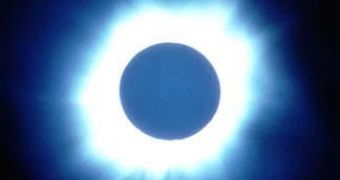It is well known that the atmosphere of the Sun is extremely dynamic, violent and excessively hot, ejecting massive quantities of matter into the surrounding space, basically every minute. But what drives and, more important, how these processes are driven remain mostly a mystery. Current and past observations with JAXA's Hinode Solar Observatory revealed that the source of these solar flares is the massive magnetic fields that spread throughout the whole atmosphere of the Sun.
Computer simulations replicating the conditions on the Sun, made by Dr Michelle Murray from the Mullard Space Science Laboratory at University College London, and based on observations made with the Hinode Observatory, revealed that the pressure at the base of the Sun's magnetic field produces massive jets of hot gas which is being lifted into the solar atmosphere. As soon as the magnetic pressure is reduced, the ascension of the solar flare immediately stops, causing it to fall back to the surface under the gravitational pull of the Sun.
These continual changes in pressure are determined by the rearrangement of the magnetic field of the Sun, thus making magnetic loops increase and decreasing pressure accordingly. "EIS has observed the Sun's fountains in unprecedented detail and it has enabled us to narrow down the fountains' origins for the first time," said postgraduate student Deb Baker of MSSL. EIS stands for the Extreme Ultraviolet Imaging Spectrometer instrument on board Hinode.
"We have also been able to find what drives the fountains by using computer experiments to replicate solar conditions," added Baker.
"The computer experiments demonstrate that when a new section of magnetic field pushes through the solar surface it generates a continual cycle of fountains, but new magnetic fields are constantly emerging across the whole of the solar surface and so our results can explain a whole multitude of fountains that have been observed with Hinode," says Dr Murray.
The findings of the MSSL team have been detailed in the Royal Astronomical Society's National Astronomy Meeting, which took place yesterday in Belfast.

 14 DAY TRIAL //
14 DAY TRIAL //